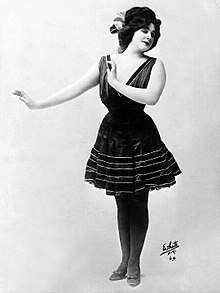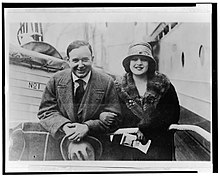Julian Eltinge
Julian Eltinge (May 14, 1881 – March 7, 1941), born William Julian Dalton, was an American stage and film actor and female impersonator. After appearing in the Boston Cadets Revue at the age of ten in feminine garb, Eltinge garnered notice from other producers and made his first appearance on Broadway in 1904. As his star began to rise, he appeared in vaudeville and toured Europe and the United States, even giving a command performance before King Edward VII. Eltinge appeared in a series of musical comedies written specifically for his talents starting in 1910 with The Fascinating Widow, returning to vaudeville in 1918. His popularity soon earned him the moniker "Mr. Lillian Russell" for the popular beauty and musical comedy star.
Julian Eltinge | |
|---|---|
Eltinge, c. 1908 | |
| Born | William Julian Dalton May 14, 1881 |
| Died | March 7, 1941 (aged 59) New York City, U.S. |
| Resting place | Forest Lawn Memorial Park, Glendale |
| Occupation | Actor, female impersonator |
Hollywood beckoned Eltinge and in 1917 he appeared in his first feature film, The Countess Charming. This led to other films, including 1918's The Isle of Love with Rudolph Valentino and Virginia Rappe. By the time Eltinge arrived in Hollywood, he was considered one of the highest paid actors on the American stage; but with the arrival of the Great Depression and the death of vaudeville, Eltinge's star began to fade. He continued his show in nightclubs but found little success. He died in 1941 following a show at a New York City nightclub.
Early years
Eltinge was born in Newtonville, Massachusetts to Julia Edna Baker and Michael Joseph Dalton.[1] It is believed that his father was a mining engineer and that early in his life he traveled out west with his father, ending up in Butte, Montana. In his early teens, Eltinge dressed in women's clothing and performed in saloons patronized by ranchers and miners. Upon discovering this in 1899, his father beat him and his mother sent him back to Boston, where the 17-year-old worked in dry goods as a salesman while studying dance.
The early film star Pauline Frederick and Eltinge were childhood friends. They met up again at boarding school in Boston when Eltinge was already making a name for himself on the vaudeville stage. He dared her to apply to one of the music halls, which was the start of her career on stage and in films.[2]
Most sources cite his first female role originally having been at the age of ten with the Boston Cadets Review at the Tremont Theater in Boston. He is reported to have played the role so well that the next year the revue was written around him which led to minor roles elsewhere. But as to how he came to perform as a female a decade later with the Boston Cadets, sources differ. In some versions he was taking cakewalk lessons from a Mrs. Wyman's dance studio when he demonstrated to his teacher an incredible ability to emulate females. It is said to be Mrs. Wyman who encouraged William to study the art of female impersonation. Boys often play female roles in all-male theater groups.

Broadway and vaudeville
Eltinge's first appearance on Broadway was in the musical comedy Mr. Wix of Wickham which opened September 19, 1904 at the Bijou Theatre in New York City. The show was produced by E. E. Rice and included music by Jerome Kern among others.
During this time Eltinge began performing in vaudeville. Unlike many of the female impersonation acts that existed at that time, like Bert Savoy, Eltinge did not present a caricature of women but presented the illusion of actually being a woman. He toured simply as "Eltinge" which left his sex unknown and his act included singing, dancing and quick costume changes in a variety of female roles, including a Gibson Girl-like role called "The Sampson Girl". At the conclusion of his performances, he would remove his wig, revealing his true nature to the surprise of the often unknowing audience.
In 1906 Eltinge made his London debut at the Palace Theater. While in London, Eltinge gave a performance for King Edward VII, who later presented him with a white bulldog. The next year, Eltinge made his New York debut at the Alhambra Theater to critical acclaim. From 1908-09, he toured with Cohan and Harris Minstrels.
By 1910, Eltinge had reached the height of his fame. Sime Silverman, Editor of Variety, called him "as great a performer as there is today".[3]
The Fascinating Widow and beyond
.jpg)
In 1911, Eltinge opened one of his most famous shows, The Fascinating Widow at New York's Liberty Theater. In it he played Hal Blake who disguises himself as "Mrs. Monte" in a Charley's Aunt-like plot. The show only ran 56 performances in New York, but toured the nation successfully for several years.
The success of this show led producer A. H. Woods to give Eltinge one of theatre's highest honors, having a theatre named for him. A year to the day that The Fascinating Widow opened, Woods opened the Eltinge Theatre on New York's 42nd Street designed by noted theater architect Thomas W. Lamb. Eltinge himself never performed in his namesake building. After serving as a legitimate theater for many years, it became a notorious burlesque house and was shut down during a "public morality" campaign in 1943, before becoming a cinema the next year. The theater is now part of the AMC Empire 25 cineplex having been lifted and moved in its entirety down the block from its original location.
Following on the success of The Fascinating Widow, Eltinge performed in two other comedies that had similar success, The Crinoline Girl which opened in 1914 and Cousin Lucy (with music by Kern) the next year.
Hollywood and film career

In 1914 Eltinge starred in silent picture versions of The Crinoline Girl followed by Cousin Lucy the next year. According to Anthony Slide's The Encyclopedia of Vaudeville, he also had a cameo role in a film entitled How Molly Malone Made Good in 1915. Eltinge's first real screen success came in 1917 in The Countess Charming. His role in the film was again a double role with him playing both a male and said male in female garb.
Settling in Hollywood, Eltinge made three films in 1917 and also in 1918. During this time he wrote and produced a vaudeville group called "The Julian Eltinge Players". With this group he returned to the vaudeville stage appearing at New York's Palace Theatre in 1918, where he was paid one of the highest salaries in show business: $3,500 a week. The next year he returned again in a new vaudeville review with sets by the French designer Erté.
By 1920, Eltinge was very wealthy and was living in one of the most lavish mansions in Southern California, Villa Capistrano. He appeared with Rudolf Valentino in the 1920 film An Adventuress (released as The Isle of Love in the U.S.). After filming, Eltinge continued touring onstage and did so until 1927. He also made two films, Madame Behave and The Fascinating Widow, in 1925.
Personal life

Despite the graceful femininity he exhibited on stage, Eltinge used a supermasculine facade in public to combat the rumours of his homosexuality. This sexual duality led to Dorothy Parker's creation of the term "ambisextrous" to describe him.[4]
Eltinge may have been a gay man,[5] as Milton Berle and many others who worked with him believed. Actress Ruth Gordon stated in a New York Times article that he was "as virile as anybody virile."[6] There is no existing record of a lover of either sex, though stories did abound.
Later years and death
Eltinge was one of many show business figures to be hit hard by the 1929 stock market crash. By the 1930s, the female impersonations that he had built his career on had begun to lose popularity, as did vaudeville in general. Eltinge resorted to performing in nightclubs. Crackdowns on cross-dressing in public – an attempt to curb homosexual activity – prevented Eltinge from performing in costume.
On February 25, 1941, Eltinge fell ill while performing at Billy Rose's Diamond Horseshoe nightclub.[7] He was taken home and died in his apartment ten days later on March 7. His death certificate lists the cause of death as a cerebral hemorrhage.
In popular culture
A reference to Julian Eltinge is found in Buster Keaton's comedy Seven Chances (1925). In the film, Keaton's character must marry before 7:00 PM in order to receive a large inheritance. After many failed attempts to find an instant bride, he sees a poster with a woman's photo outside a performance hall and, in an act of desperation, enters to ask for her hand in marriage. While Keaton is inside, a stagehand removes some boxes to reveal the woman's name on the poster: Julian Eltinge. Keaton then emerges from the theater with a black eye and his boater hat smashed down over his head.
See also
References
Notes
- Great Stars of the American Stage; A Pictorial Record Profile#70 by Daniel Blum c. 1952 (this second edition c. 1954)
- (The Red Letter, April 17, 1920, p.332)
- Variety, April 1, 1910.
- Dorothy Parker, Complete Poems (New York: Penguin Books, 1999), pg. 206
- Lillian Faderman and Stuart Timmons, Gay L.A.: A History of Sexual Outlaws, Power Politics, and Lipstick Lesbians, Basic Books: New York, 2006, p. 19
- Holusha, John (March 24, 2000). "A Theater's Muses, Rescued; Mural Figures Recall Celebrity of a (Well-Painted) Face". The New York Times.
- Louisville Courier-Journal, March 8, 1941.
Bibliography
- Banham, Martin ed. The Cambridge Guide to Theatre. Cambridge University Press, New York, NY. 1992.
- Bloom, Ken. Broadway: An Encyclopedic Guide to the History, People and Places of Times Square. Facts on File, New York, NY. 1991.
- Bordman, Gerald and Thomas L. Hischak. The Oxford Companion to American Theatre, 3rd Edition. Oxford University Press, New York, NY, 2004.
- Slide, Anthony. The Encyclopedia of Vaudeville. Greenwood Press, Westport, CT. 1994.
- Toll, Robert C. On With the Show! The First Century of Show Business in America. Oxford University Press, New York, NY. 1976.
- Winford, E. Carlton. Femme Mimics. Winford Company, Dallas, TX. 1954.
External links
| Wikimedia Commons has media related to Julian Eltinge. |
- Works by or about Julian Eltinge at Internet Archive
- Julian Eltinge at the Internet Broadway Database

- Julian Eltinge on IMDb
- Photographs of Julian Eltinge held by the New York Public Library for the Performing Arts
- Julian Eltinge Project - A comprehensive website with many images and much detailed information.
- Review of Eltinge film The Countess Charming / Calgary Herald - 03 November 1917
- Julian Eltinge at Find a Grave